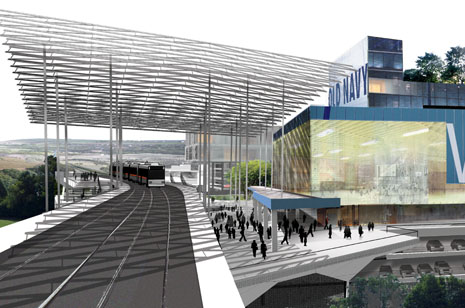
FAYETTEVILLE, Ark. – Visioning Rail Transit in Northwest Arkansas: Lifestyles and Ecologies, a project of the University of Arkansas Community Design Center that envisions how a light rail system could impact the region’s development, has won a 2010 American Architecture Award. The American Architecture Awards, sponsored by the Chicago Athenaeum: Museum of Architecture and the European Centre for Architecture Art Design and Urban Studies, are the “highest and most prestigious distinguished building awards in the United States that honor new and cutting-edge design.” The annual award program champions American architecture to both national and international audiences.
This year, a distinguished group of Turkish architects, educators and journalists awarded 47 projects from more than 1,000 submitted for architecture, landscape architecture and urban design from firms across the United States and around the world.
The Community Design Center is an outreach program of the Fay Jones School of Architecture, whose mission is to advance creative development in Arkansas through education, research and design solutions that enhance the physical environment. The center also won this award in 2009 for Porchscapes, a 43-unit affordable housing neighborhood, designed to demonstrate low-impact development technologies in stormwater management.
Jeff Huber, project designer, said the Chicago Athenaeum is a seminal architecture organization that “exhibits great architecture from around the world,” with American and international architecture awards programs.
“Designs are awarded based on their ability to add cultural, social, environmental and economic value to the built environment,” he said.
On Nov. 4-7, the Chicago Athenaeum, together with the European Centre for Architecture Art Design and Urban Studies, will present a special exhibition of the winning projects at “The City and the World: Madrid Symposium.” After Madrid, the exhibition will travel to the Contemporary Space Athens museum in Athens, Greece, and then to Istanbul in April 2011.
“It’s positive because it puts the work out there — especially work being done here in Arkansas,” Huber said. “People don’t think of Arkansas as an incubator of architectural and urban precedents nationally or internationally. Awards like this change that mentality.”
The winning project, Visioning Rail Transit in Northwest Arkansas, was a scenario planning study completed in 2007. It was created from three studios conducted at the Fay Jones School of Architecture with fourth- and fifth-year architecture students in spring 2006. It also included design studies from a studio that Steve Luoni, director of the center, conducted with graduate students while he was the Ruth and Norman Moore Visiting Professor at Washington University in St. Louis in fall 2006.
“Visioning Rail Transit in Northwest Arkansas was developed as a model to promote transit-oriented development, which integrates land use and affordable housing with transportation planning,” Luoni said. “The project points the way towards achieving sustainable communities, particularly for regions of our size. Keep in mind that the highly touted rail systems in Portland, Ore., and Salt Lake City were first developed when their population counts approximated what our region’s will be in under 10 years.”
By 2050, the populations of Fayetteville and Bentonville are projected to double, with the populations of Rogers and Springdale projected to triple, according to the study, which takes short term economic downturns into consideration.
With a grant from the National Endowment for the Arts and other contributions, the center published 2,000 copies of the study in 2009 and distributed them to the public and stakeholders.
The American Architecture Award is the eighth design award the Community Design Center has received for Visioning Rail Transit in Northwest Arkansas, including a recent citation award from the Arkansas Chapter of the American Institute of Architects. Huber said he thinks the project keeps getting noticed because it’s progressive and puts “a visioning plan in place.” Huber added, “Currently, transportation stimulus funding is favoring light rail projects, projects like this.”
Scenario planning starts with “what if” propositions to visualize different futures. In this case, the proposition asked, if light rail transit came to the region, what types of urban lifestyles and ecologies would come from implementing this particular transportation mode. That idea is in opposition to the current trend of low-density sprawl generated by total reliance on the automobile and highway planning.
“Typically, we develop and design urban environments in a short-term vision — three to five years out. That’s why we see the things we see. There are no larger visions of urban design or city-making that envision how we want to live in 40 years,” Huber said. “It at least gets you in the game, showing us the kind of densities that will be needed in order to make light rail transit feasible in northwest Arkansas.”
When sprawl is controlled with increased urban density, it increases the area’s economic development power and desirability, enabling the region to attract creative class people and businesses it wants to see establish here, Huber said. Controlling sprawl also preserves natural space and relieves traffic congestion on highways.
Huber thinks the project also garners attention and recognition because it is unlike projects derived from many architecture programs, which can be highly theoretical. “We set up a realistic foundation for real problem-setting and problem-solving through a studio conducted through a school of architecture. It makes the Fay Jones School of Architecture a prominent outlet for research and outreach, as it should be.”
Contacts
Steve Luoni, director
Community Design Center
479-575-5108, sluoni@uark.edu
Jeff Huber, project designer
Community Design Center
479-575-4980, jeh013@uark.edu
Michelle Parks, senior director of marketing and communications
Fay Jones School of Architecture and Design
479-575-4704,
mparks17@uark.edu